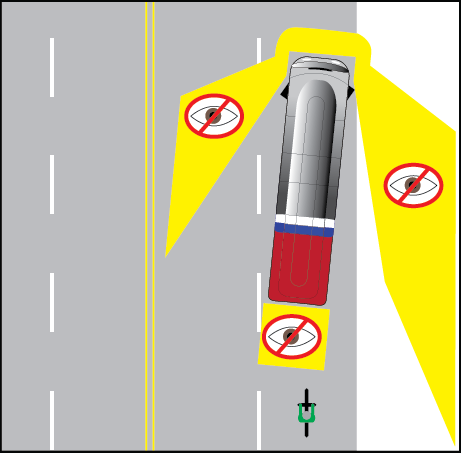Biking near Buses: Watch Out for Blind Spots!
Bus operators are trained to look for cyclists, but they can’t see you if you’re in their blind spot. Come see a bus’s blind spots for yourself at Fort Totten!
Unless you’ve driven a bus (or large truck) yourself, it can be hard to get a feel for where the blind spots are in real life. This Bike to Work Day (May 20th), come see for yourself what bus operators can — and, more importantly, can’t — see on the road. Metro’s Fort Totten pit-stop will feature a live Metrobus demonstration with experienced Metrobus instructors. Hop in the driver’s seat (and who doesn’t want to experience that air cushioning!), check the mirrors, and you’ll know where it’s safe to ride. While you’re there, brush up on your skills securing your bike on the bus’ bike rack.
When buses and bikes share space on the road, visibility is the key to safety. Metrobus operators receive regular training on safety around bicyclists, but they need your help as well.
Remember these tips when riding near buses:
Make sure the operator can see you. As you can see in the graphic below, buses have large blind spots on all sides. Stay clear! Make eye contact with the driver to make sure he/she sees you. Use lights when riding at night.
Watch the bus’ turn signals. Operators will signal when they change lanes, pull over at a stop or merge back into traffic. When in doubt, assume the bus will move.
Don’t pass on the right. Buses make frequent stops and wide right turns. Don’t get caught on the inside of these maneuvers. It could also put you on a collision course with people boarding and exiting the bus. If you can’t safely pass on the left, wait. Better to spend a few seconds practicing your trackstand than risk getting crunched.



If I’m the first cyclist to put my bike in the rack, which slot should I use?
It’s best to use the inner/rear slot first, if only because it’s easier to add the 2nd bike in front of (rather than behind) one that’s already mounted.
@James
That’s what I thought. But last time I tried the bus driver protested and forced me to use the forward-most slot. He said it helped him gauge where he was at night. But that’s also putting my bike at risk if he rear-ends somebody.
I humbly retract my earlier statement!
Although some cyclists (myself included) might intuitively go rear-first to make it easier for the subsequent cyclist, most operators prefer it the other way around. As your driver mentioned, the bicycle provides a stronger visual cue to the front of the expanded vehicle envelope. At the end of the day, there’s no official regulation about which slot you pick first (after all, a half-full rack can end up in either configuration as bikes come on and off along the route). But if the operator prefers front-first, I would defer to his/her judgement.